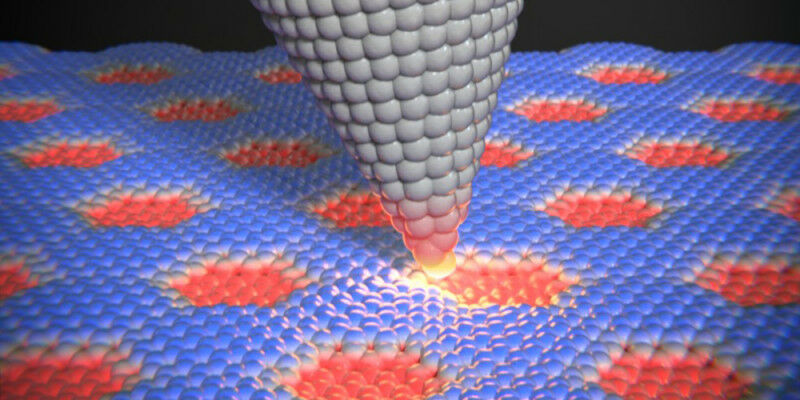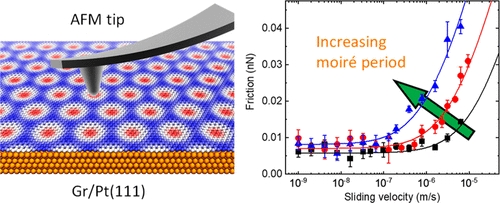诸平

据瑞士巴塞尔大学 (University of Basel) 2022年12月7日报道,令人惊讶的是,原子力显微镜(atomic force microscope简称AFM)尖端与莫尔上层结构(Moiré superstructures)之间的摩擦取决于尖端在表面上移动的速度(Unexpected speed-dependent friction / Unexpected speed-dependent friction in graphene)。
在宏观世界中,摩擦力不取决于两个表面相互移动的速度,但来自巴塞尔大学和以色列特拉维夫大学(Tel Aviv University)的研究人员现在已经在铂表面上的特殊石墨烯结构中精确观察到这种效应。相关研究结果于2022年11月30日已经在《纳米快报》(Nano Letters)杂志网站发表——Yiming Song, Xiang Gao, Antoine Hinaut, Sebastian Scherb, Shuyu Huang, Thilo Glatzel, Oded Hod, Michael Urbakh, Ernst Meyer. Velocity Dependence of Moiré Friction. Nano Letters, Publication Date: November 30, 2022. DOI: 10.1021/acs.nanolett.2c03667. https://pubs.acs.org/doi/10.1021/acs.nanolett.2c03667
由于其低摩擦特性,由单原子层组成的材料对于以减少摩擦为目标的应用非常感兴趣,例如硬盘、卫星或太空望远镜的移动部件。一个这样的例子是石墨烯,它由蜂窝状排列的单层碳原子组成,并且正在研究以作为润滑层的潜在用途。事实上,之前的研究表明,石墨烯带可以在金表面上移动,几乎没有摩擦。
粗糙表面的惊人结果(Surprising results with a rough surface)
如果将石墨烯应用于铂金表面,它会对可测量的摩擦力产生重大影响。现在,巴塞尔大学和特拉维夫大学的物理学家在《纳米快报》杂志上报道说,在这种情况下,摩擦力取决于原子力显微镜(AFM)尖端在整个表面移动的速度。这一发现令人惊讶,因为根据适用于宏观世界的库仑定律(Coulomb’s law),摩擦并不取决于速度。
与铂基板结合,石墨烯不再仅形成碳原子的六角蜂窝状图案,而是形成称为莫尔超晶格(Moiré superlattices)的超结构。然后表面不再是完全平坦的并且表现出一定程度的粗糙度。
瑞士纳米科学研究所(Swiss Nanoscience Institute)和巴塞尔大学物理系的恩斯特·迈耶(Ernst Meyer)教授解释说:“如果我们将AFM尖端以低速移动穿过这个略带波纹的表面,我们会测量到一个微弱且几乎恒定的摩擦力。” “然而,超过某个阈值后,摩擦会随着AFM尖端的速度而增加,莫尔上层结构越大,摩擦变得与速度相关的阈值就越低。”上述论文的第一作者宋一鸣博士(Dr. Yiming Song音译)补充道。
研究人员发现,在尖端运动过程中,莫尔上层结构的脊处有更大的阻力。当压力足够高时,这些脊状突起在再次放松之前,由于推动尖端而发生弹性变形。这种效应会导致更大的摩擦力,摩擦力随着尖端速度的增加而增加。模拟和分析模型证实了这个国际研究小组获得的实验结果。
原子力显微镜 (AFM) 有一个带有尖锐尖端的微型悬臂梁探针,可以在被检查的表面上进行扫描。尖端和样品之间的吸引力和排斥力导致悬臂梁探头偏转,这种曲率由瞄准探头的激光束与光电探测器结合测量。然后将这些测量值逐点放在一起以生成表面的数字图像。
这种显微镜尖端也可用于分析样品的磁学或电学特性。例如,还可以分析针尖扫描样品时产生的摩擦力。
上述介绍,仅供参考。欲了解更多信息,敬请注意浏览原文或者相关报道。

Friction force microscopy experiments on moiré superstructures of graphene-coated platinum surfaces demonstrate that in addition to atomic stick–slip dynamics, a new dominant energy dissipation route emerges. The underlying mechanism, revealed by atomistic molecular dynamics simulations, is related to moiré ridge elastic deformations and subsequent relaxation due to the action of the pushing tip. The measured frictional velocity dependence displays two distinct regimes: (i) at low velocities, the friction force is small and nearly constant; and (ii) above some threshold, friction increases logarithmically with velocity. The threshold velocity, separating the two frictional regimes, decreases with increasing normal load and moiré superstructure period. Based on the measurements and simulation results, a phenomenological model is derived, allowing us to calculate friction under a wide range of room temperature experimental conditions (sliding velocities of 1–104 nm/s and a broad range of normal loads) and providing excellent agreement with experimental observations.
转载本文请联系原作者获取授权,同时请注明本文来自诸平科学网博客。
链接地址:https://wap.sciencenet.cn/blog-212210-1367095.html?mobile=1
收藏


